What Type Of Hydroponic System Should I Use?
There are many variations of Hydro systems, finding the right one for you depends on your skill level and growing needs. Hydroponic systems are of six main types – Water Culture, Wick, Ebb and Flow, N.F.T. (Nutrient Film Technique), Drip and Aeroponic. These are the basic types of hydroponic systems, and there are several variations based on them. Let’s talk about each of these types in more detail.
Wick System
This is one of the easiest and simplistic of the hydro systems to create. It has no moving parts and utilizes the nutrient laden water wicking upwards into the growing medium.
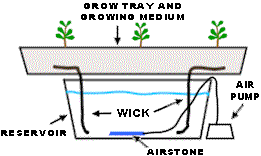
It can be used with the majority of inert mediums available: Coca Fiber, Vermiculite, Perlite, Hydroton.
The only real drawback is that the reservoir requires attention to make sure that there is plenty of water available to the plant since large plants will drink a great deal of water on a daily basis. Though it is an excellent Hydroponic starter project for those just learning because of it’s simplicity.
Water Culture System
The water culture system is also an easy hydroponic system, so simple that it is used in classrooms by teachers for educational purposes.
A platform made of Styrofoam is used to hold the plants as it floats on the nutrient solution. There is an air pump that supplies the oxygen to the roots of the plants through the use of an air stone.
This system is generally used when a grower wants to plant a fast growing water loving plants such as leaf lettuce. Not all plants grow well in this system. You can build this system out of an old aquarium, a plastic storage container or any water tight container.
Another variant of this type of system is called Deep Water Culture. Which can be recirculating or not. The plants can be placed into individual containers like a 5 gallon bucket with the roots completely submerged in water with the addition of an airstone. This is more ideal for smaller grows.
A Recirculating Deep Water Culture has the same setup except all the containers are connected with piping that then connects to a main reservoir with a pump that circulates the nutrient solution through each container then back to the reservoir. This can be done through multiple containers and is often better for small to medium sized grow.
Flood and Drain/ Ebb and Flow
These systems are more intermediate yet still easy to learn and more effective than the beginner Hydro systems. Using a large grow tray, this system design utilizes a submerged pump on a timer which will flood the tray periodically with nutrient solution which is then drained back into the reservoir after the pump turns off.
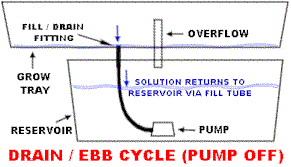
This pump will come on several times a day depending on the size of the plants, the grow medium being used and the overall temperature of the environment that the plants are in.
There are many variations on this type of system and the growing mediums that can be used with it. The whole tray can be filled with Hydroton, Grow Rocks or even just Rockwool. To make it easier to move plants around in the tray, some people use individual containers for the plants which are then filled with the desired grow medium.
The biggest disadvantage with this system is that it is vulnerable if there is a power outage, timer problems or pump failures which will then keep the plants from being properly watered. Grow mediums that don’t retain water, such at Hydroton, Perlite, Growrocks expose this system more to this vulnerability. This possibility can be mitigated through the use of high water retention mediums such as Rockwool or Coco Fiber.
Drip System – Recovery/ Non Recovery
Drip systems are the most popular of all hydroponic systems. They are simple to operate and consist of a submerged pump controlled by a timer. When the pump is turned on, the nutrient solution drips to the base of each plant through a tiny drip line.
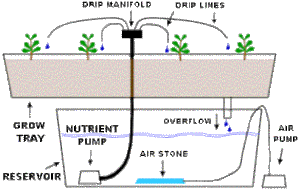
The Drip System is of two types; the Recovery Drip System where any excess nutrient solution does not get used is collected and put back into the reservoir to be reused. Then there is the Non-Recovery System, where the run-off is not collected.
The recovery system is more efficient and popular as it makes a better utilization of the nutrient solution. Also, it is possible to use a more inexpensive timer to go with this system, one that does not require you to precisely control the watering cycles.
The non-recovery system requires a very precise timer to operate to allow for the watering cycles to be adjusted. This ensures that the plants get a sufficient amount of the nutrient solution and that the runoff is minimized.
The non-recovery system does have an advantage over the recovery system as it requires less maintenance. Also, since the excess nutrient solution is not recycled and used in the reservoir again, this ensures that the pH and the nutrient strength of the reservoir are not affected.
So you can fill the reservoir with a pH adjusted nutrient solution and don’t have to worry about it until you need to mix more. A recovery system on the other hand will require regular monitoring and maintenance because of the variance in the pH and nutrient strength levels.
Nutrient Film Technique/ N.F.T.
This is among the most popular of Hydroponic Systems and is often used commercially for consistent production. This tends to be used by more experienced growers.
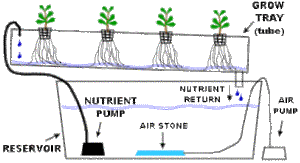
The N.F.T. Systems utilize long tubes or channels with perfectly spaced holes drilled in the top spaced depending on the type of crop being grown. Usually the submersed pump is placed in a nutrient water reservoir below the tubes and often runs continuously.
The water levels in the tubes can be adjusted according to the type of crop being grown but generally is set to a level that allows the nutrient solution to flow constantly through the root zone. If the water level is deep enough, though it isn’t always necessary air stones can be added to help boost oxygen levels for higher production.
Rockwool and Hydroton are the most popular grow mediums to use with this system and sometimes even no medium needs to be used at all which helps to save money changing out mediums between harvests.
The water level in the tubes or channels can be set high enough so that pump problems won’t have any real effect on the plants. This can be a very dynamic, high oxygen rendering yet stable system.
Aeroponics
This is perhaps among the most technical and attention intensive of Hydroponic systems. In this system the roots dangle down into a sealed container and are then periodically misted with sprayers on a timer. This is a great method for nutrient absorption by using a fine mist with more than adequate amounts of oxygen.
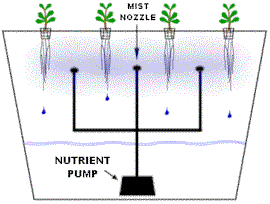
Because the roots are only exposed to water through a periodic fine mist this leaves it susceptible to quickly drying out if the timer or the pump were to fail. Sometimes a secondary backup pump for the misters can be installed to help prevent this from being an issue.
The increase in growth rate and yield is about 10% with an Aeroponic system. So unless you plan on being routinely present to check on the system, it’s often considered less stressful to go with a more stable standard Hydro system.
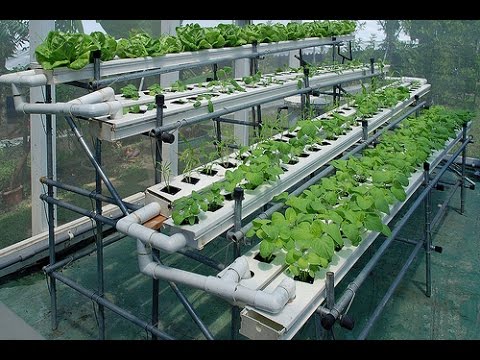
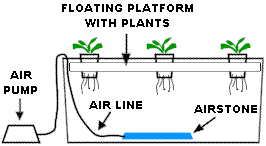
Leave a Reply
You must be logged in to post a comment.